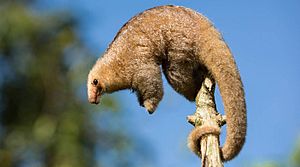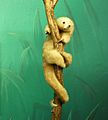Silky anteater facts for kids
The silky anteater is also known as the pygmy anteater. It is the smallest type of anteater in the world! You can find these tiny creatures in southern Mexico and parts of Central and South America.
Silky anteaters are active at night, which means they are nocturnal. They live by themselves high up in trees. One cool thing about them is their two big claws on each front paw. They use these claws to hold onto branches and to protect themselves. They can even use their tail to grab things, almost like another hand! Their fur is super soft and can be yellow or grey.
Just like other anteaters, they are insectivores. This means they mostly eat insects, especially ants.
Contents
About the Silky Anteater
The silky anteater is quite small, usually weighing less than a pound. It is about the size of a squirrel! Its scientific name is Cyclopes didactylus. This little animal is perfectly designed for life in the trees.
Where Silky Anteaters Live
Silky anteaters live in warm, tropical forests. They are found from southern Mexico all the way down to parts of South America. This includes countries like Brazil, Colombia, Ecuador, and Peru. They prefer areas with lots of vines and epiphytes (plants that grow on other plants).
- They live in rainforests and dry forests.
- They spend almost all their time in trees.
- They are found in lowlands, not high mountains.
What Silky Anteaters Eat
Silky anteaters are insectivores, meaning their diet is made up of insects. They mostly eat ants and termites. They have a long, sticky tongue that helps them catch these tiny creatures.
- They use their sharp claws to break open ant and termite nests.
- Their long tongue can reach deep into tunnels to get insects.
- They can eat thousands of ants in one night!
Cool Features of the Silky Anteater
These small anteaters have several special features that help them survive.
- Claws: They have two very large claws on their front paws. These claws are great for gripping branches. They also use them for defense if they feel threatened.
- Tail: Their tail is prehensile, which means it can grasp things. They use it like a fifth limb to help them climb and balance.
- Fur: Their fur is very soft and dense. It helps them blend in with tree bark, protecting them from predators. It also keeps them warm.
- Nocturnal: Being active at night helps them avoid predators like hawks and jaguars.
Life Cycle and Behavior
Silky anteaters are solitary animals, meaning they live alone. They are very shy and hard to spot in the wild.
- They usually have one baby at a time.
- The mother carries her baby on her back.
- They build nests inside hollow trees or vines.
- When they feel scared, they stand on their back legs and raise their front paws, ready to defend themselves with their sharp claws.
Images for kids
-
Silky anteater sleeping, Damas Island, Costa Rica
See also
 In Spanish: Hormiguero pigmeo para niños
In Spanish: Hormiguero pigmeo para niños




